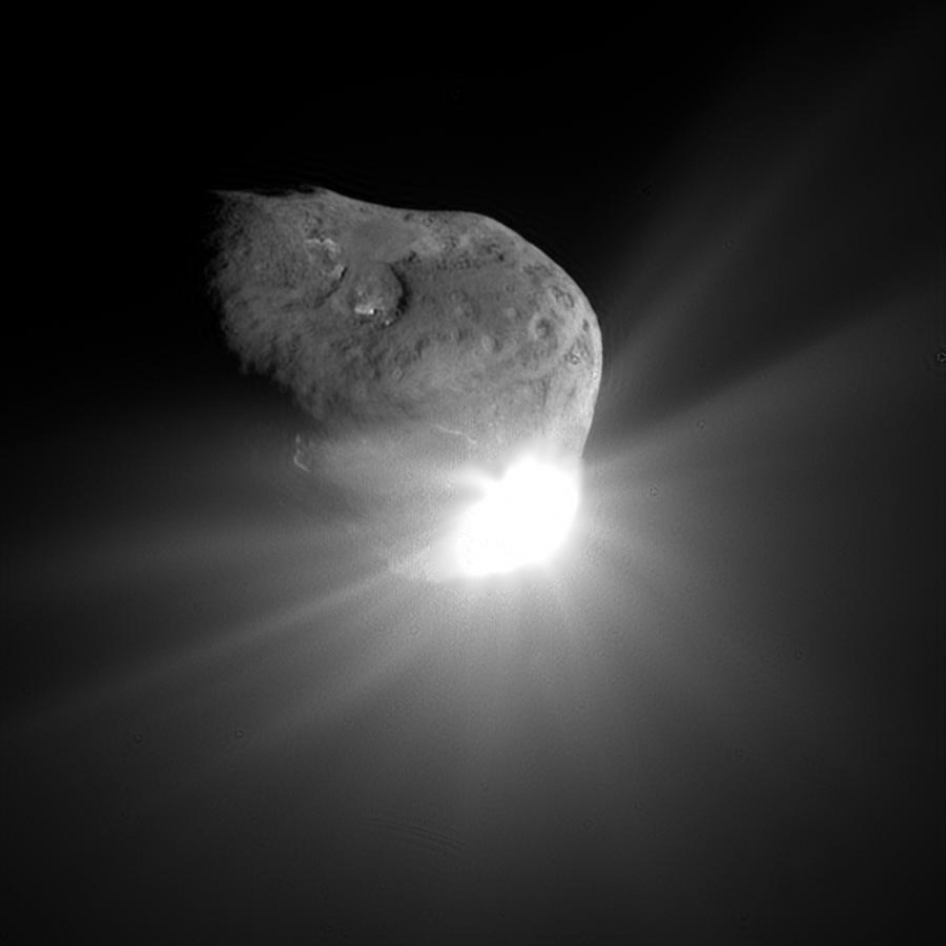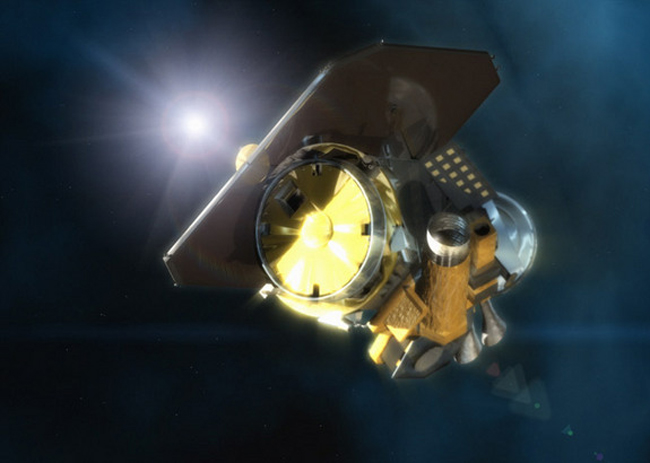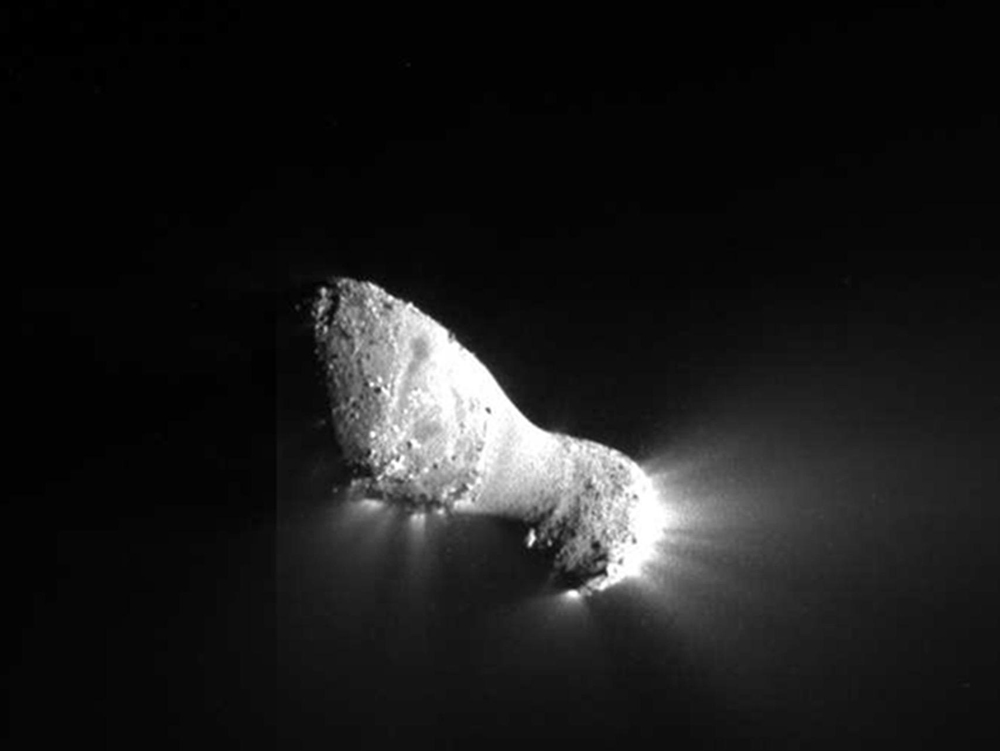Deep Impact: The Deep-Space Comet Hunter
Completing nearly a decade of comet exploration, NASA's Deep Impact mission was the most-traveled deep-space comet hunter of its time. The spacecraft visited two comets and captured images of two more. It also hunted for exoplanets and examined their atmospheres, then studied Earth as though it were an exoplanet. Deep Impact helped to find water on the moon and served as a relay for a series of interplanetary internet experiments. After nine years, team members lost contact with the spacecraft as it flew toward its third target.
"The impact on Comet Tempel 1, the flyby of Comet Hartley 2 and the remote sensing of Comet Garradd have led to so many surprising results that there is a complete rethinking of our understanding of the formation of comets and of how they work," Michael A'Hearn, the Deep Impact mission investigator, said in a statement at the close of the mission. "These small, icy remnants of the formation of our solar system are much more varied, both one from another and even from one part to another of a single comet, than we had ever anticipated."
Excavating a comet
The Deep Impact mission consisted of two spacecraft. The coffee-table-size main vehicle carried a second, smaller probe designed to crash into the first comet that the mission visited, Tempel-1. The spacecraft launched from Cape Canaveral, Florida, on Jan. 12, 2005. On July 1 of that year, Deep Impact rendezvoused with Comet 9P/Tempel 1 (the official name is usually shortened to Comet Tempel 1).
Deep Impact was about 10.8 feet (3.3 meters) long, 5.6 feet (1.7 m) wide and 7.5 feet (2.3 m) high. In addition to the scientific instruments, the spacecraft also carried a pair of solar panels and a debris shield to protect it from material shed by the comets it encountered. Two scientific instruments, the High-Resolution Instrument (HRI) and the Medium-Resolution Instrument (MRI), collected images of comets and planetary bodies. Deep Impact also carried an infrared spectrometer.
On July 4, 2005, the spacecraft dropped its smaller impactor craft into the path of Tempel 1. The impactor ran on battery power and carried the Impactor Targeting Sensor, a high-precision star tracker that monitored the spacecraft's trajectory and captured images of the comet at close range. The images were transmitted in real time to the main vehicle, with the final image sent only 3.7 seconds before impact.

The spacecraft also carried a disc of 625,00 names submitted by people from around the world that was vaporized with the the craft.
The 816-lb. (370 kilograms), primarily copper impactor delivered 19 gigajoules of kinetic energy to carve out a crater on Tempel 1. That's as much energy as 4.8 tons (4.35 metric tons) of TNT. Traveling at 23,000 mph (37,000 kilometers per hour), the impactor blew out a crater about 500 feet (150 m) wide, according to measurements made by NASA's Stardust mission in 2011.
Heat and radiation from the sun cook the surface of these dusty snowballs, creating singed outer crusts. The cloud of debris blowing off the comet from the small spacecraft's collision revealed the first-ever view of the pristine material found inside of a comet and revealed to astronomers that Tempel 1 is covered in a fine powder, "more like talcum powder than beach sand," A'Hearn said.
"You have to think of it in the context of its environment," Pete Schultz, Deep Impact scientist from Brown University in Rhode Island said in a statement. "This city-sized object is floating around in a vacuum. The only time it gets bothered is when the sun cooks it a little or someone slams an 820-pound wake-up call at it at 23,000 miles per hour."
The mission's scientists also determined that comets are surprisingly fluffy, with a comet nucleus composed of at least 50 percent empty space and the surface shell at least 75 percent empty. The result confirmed previous indirect observations that suggested comets could be more porous than had been expected, A'Hearn said.
Observations by NASA's Swift space telescope revealed that approximately 250,000 tons (227,000 metric tons) of water were released due to the impact; this was a far greater amount than originally predicted. Swift's X-ray observations revealed that the comet took 12 days to return to normal.
Swift's X-ray observations also provided new insights into how the solar wind strips material from comets and planets.
"For the first time, we can see how material liberated from a comet's surface migrates to the upper reaches of its atmosphere," John Nousek, said in a statement. Nousek was the director of mission operations at Penn State, where the spacecraft's science and flight operations were controlled. "This will provide fascinating information about a comet's atmosphere and how it interacts with the solar wind. This is all virgin territory."
The Deep Impact team also worked with NASA's Spitzer Space Telescope to create a list of cometary ingredients. "Now, we can stop guessing at what's inside comets," A'Hearn said. "This information is invaluable for piecing together how our own planets as well as other distant worlds may have formed."
These observations indicated that the comet may have been born in the part of the solar system now occupied by Uranus and Neptune. This finding supports the Nice model of planetary formation, which suggests that those two planets traded places and scattered comets into deep space.

EPOXI, two missions in one
After the probe flew past Tempel 1, the Deep Impact mission team submitted a proposal for an extended mission that would really be two missions in one: a visit to another comet and a hunt for exoplanets.
The Deep Impact eXtended Investigation (DIXI) combined with the Extrasolar Planet Observation and Characterization (EPOCh) investigation to become a new mission, called EPOXI. (The spacecraft kept the name Deep Impact.)
Initially, the extended mission called for Deep Impact to visit Comet 85P/Boethin, which was last observed in 1986. Because of its 11.8-year orbit, that comet can be seen from Earth only during the six months when the comet is closest to the sun. Astronomers used 10 of the world's largest telescopes, along with Spitzer, to search for radiation from the comet in what A'Hearn called "an heroic effort." Unfortunately, they were unable to find their target, and researchers proposed that it may have broken up due to a catastrophic explosion.
With the loss of the original target, astronomers turned to Comet Hartley 2. Discovered in March 1986, the comet had a well-known orbit. But it would take an additional two years to reach the target compared to what a trip to Boethin would have required.
During its extended mission, EPOXI turned its mechanical eyes toward exoplanets. In the days before NASA's planet-hunting Kepler spacecraft, observing worlds around other stars was a greater challenge. Deep Impact worked to change that.
The spacecraft studied massive gas giants orbiting five different stars in days or even hours — worlds known as hot Jupiters. Each of the five targets were suspected of hosting a second, smaller planet. Deep Impact's goal was to study the hot Jupiters to see if gravity from such unseen planets might be tugging on the orbits of the known worlds, causing them to wobble slightly.
While EPOXI didn't find any exoplanets, it did discover evidence that a second planet could be orbiting one of the stars, Gliese 436. Although no second planet has yet been confirmed around the star, there have been hints of another world from other sources, as well.
Deep Impact also studied a very well-known planet: Earth. The spacecraft swung by Earth five times, and studied our planet during a full rotation to better understand what a habitable terrestrial world might look like to exoplanet hunters. While other spacecraft had previously imaged the Earth and moon from space, Deep Impact was the first to observe with enough detail to see large craters on the moon and oceans and continents on the Earth, NASA said in a statement.
The observations, many of which were made into a video, revealed the changes in brightness the planet undergoes. The study also revealed sun glints, or specks of brightness similar to sunshine glancing off the hood of a car, visible from a distance of about 11 million miles (18 million km).
"These sun glints are important, because if we saw an extrasolar planet which had glints that popped up periodically, we would know that we were seeing lakes, oceans or other large bodies of liquid, such as water," Deming said. "And if we found large bodies of water on a distant planet, we would become much more optimistic about finding life."
EPOXI also observed Earth in infrared light, which is well beyond the range of human sight. Red light produces a better contrast between land and water and helps plants to stand out.
"People think of land as being greenish, but that's because our eyes aren't sensitive in the infrared," Deming said. "Vegetation actually shows up better in the infrared."
The spacecraft also played a key role in discovering the first clear evidence of water on the surface of the moon. Working with India's Chandrayaan-1 spacecraft and NASA's Cassini space probe, Deep Impact revealed that a dew-like liquid forms daily on the moon, then dissipates, hydrating the entire lunar surface during some portion of the lunar day.

Hartley 2
The key feature of Deep Impact's extended mission was its flyby of comet Hartley 2. The spacecraft passed within 435 miles (700 km) of the comet on Nov. 4, 2010, making Hartley 2 the fifth comet nucleus visited by any spacecraft. As Deep Impact flew closer to Hartley 2, the probe observed an increased amount of cyanide released from the comet without a corresponding release of dust, over an eight-day period in September.
"We have never seen this kind of activity in a comet before, and it could affect the quality of observations made by astronomers on the ground," A'Hearn said in a statement.
The spacecraft also flew through a cometary ice storm generated by jets of carbon dioxide gas that carried tons of water ice from the comet every second, A'Hearn said. This was the first time astronomers saw chunks of ice in the cloud surrounding a comet or jets definitively powered by carbon dioxide gas, he said. The team looked for similar events around Tempel 1 but didn't see them.
"When we first saw all the specks surrounding the nucleus, our mouths dropped," Schultz said in a statement. "Stereo images reveal that there are snowballs in front [of] and behind the nucleus, making it look like a scene in one of those crystal snow globes."
Deep Impact also provided the first images of a comet clear enough that scientists could link jets of dust and gas with specific surface features. The researchers found that carbon dioxide, not water ice, served as the propulsive force for the jets on Hartley 2.
Altogether, the data suggested that Hartley 2 could be an entirely new breed of comet. At the time, researchers debated whether comets formed from a single mass of dust and ice drawn together by gravity or if a hodge-podge of smaller comets built up their cores over time. Hartley 2 turned out to have at least two, maybe three different types of ice in its core, with an overall composition that was very consistent, raising a third possibility.
"We haven't seen a comet like this before," Michael Mumma, of NASA's Goddard Space Flight Center, said in a statement. "Hartley 2 could be the first of a new breed."
Hartley 2 is a hyperactive comet, spinning around on one axis while simultaneously tumbling around on another. Hyperactive comets make up 5 to 10 percent of all comets. With jets and other activity driven by carbon dioxide, processes such as outgassing on hyperactive comets are different from those on normal comets.
After it flew by Hartley 2, Deep Impact made observations of comets Garradd and ISON, which fly in from the outermost reaches of the solar system. The team members also launched a hunt for a third target for the spacecraft.
Loss of contact
On Aug. 8, 2013, NASA lost contact with the Deep Impact spacecraft. Unfortunately, it had not yet returned any of its images of Comet ISON. At that point, the spacecraft had traveled about 4.7 billion miles (7.58 billion km) into space.
After losing contact, mission controllers spent several weeks trying to uplink commands to reactivate Deep Impact's onboard systems. A problem with computer timing likely led to a loss of control of the spacecraft's orientation in space, NASA said. As a result, the probe had trouble positioning its radio antennas and solar arrays, making both communication and power generation difficult.
On Sept. 16, 2013, researchers determined that there was no way to recover control of the spacecraft. They recommended that NASA declare the incredibly prolific mission lost.
"Deep Impact has been a fantastic, long-lasting spacecraft that has produced far more data than we had planned," A'Hearn said in a statement. "It has revolutionized our understanding of comets and their activity."
Further reading:
- Read more about Deep Impact's extended mission on NASA's Deep Impact (EPOXI) page.
- Learn more about the History of Tempel 1.
- Learn more about Comet Hartley 2.
Join our Space Forums to keep talking space on the latest missions, night sky and more! And if you have a news tip, correction or comment, let us know at: community@space.com.
Get the Space.com Newsletter
Breaking space news, the latest updates on rocket launches, skywatching events and more!

Nola Taylor Tillman is a contributing writer for Space.com. She loves all things space and astronomy-related, and enjoys the opportunity to learn more. She has a Bachelor’s degree in English and Astrophysics from Agnes Scott college and served as an intern at Sky & Telescope magazine. In her free time, she homeschools her four children. Follow her on Twitter at @NolaTRedd










